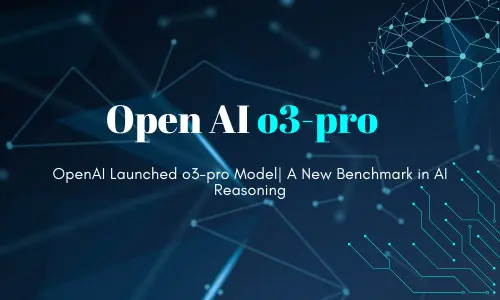OpenAI Launched o3-pro Model| A New Benchmark in AI Reasoning

What is a Headless CMS? | Benefits and Use Cases
June 12, 2025
SCL Deep Dive APAC 2025: Fresh Format, Inspiring Community Voices
June 24, 2025On June 11, 2025, OpenAI unveiled its latest achievement in artificial intelligence, the o3-pro model, setting a new standard for reasoning capabilities in AI systems. This release marks a significant milestone in the evolution of AI, promising enhanced performance in complex tasks like mathematics, science, and coding. Designed to push the boundaries of what AI can achieve, the o3-pro model builds on its predecessors with improved accuracy, clarity, and tool integration. Let’s explore what makes this model a game-changer and how it’s shaping the future of AI technology.
What is the o3-pro Model?
The o3-pro model is OpenAI’s most advanced reasoning model to date, succeeding the o3 and o1-pro models. Unlike traditional language models that prioritize speed and broad knowledge, this model is engineered to tackle intricate problems by breaking them down step-by-step. This approach, often referred to as “chain-of-thought” reasoning, allows the system to deliver more reliable and precise responses, particularly in technical domains. The model’s launch has sparked excitement among developers, researchers, and businesses eager to leverage its capabilities.
Key Features of the o3-pro Model
The o3-pro model stands out due to its robust feature set, which enhances its versatility and performance. It integrates advanced tools such as web search, file analysis, and Python code execution, enabling it to handle diverse tasks. Additionally, it supports computer vision for reasoning based on visual inputs and uses memory to personalize responses, making interactions more contextually relevant. These features make the model particularly valuable for applications requiring deep analysis and problem-solving.
Availability and Access
As of its launch, the o3-pro model is available to ChatGPT Pro and Team subscribers, with enterprise and educational users gaining access a week later. Developers can also tap into its capabilities through OpenAI’s API, priced at $20 per million input tokens and $80 per million output tokens. This pricing reflects the model’s high computational demands but positions it as a premium tool for mission-critical applications. However, features like image generation and temporary chats are currently unsupported, with the latter limited due to a technical issue.
Performance Breakthroughs
The o3-pro model has demonstrated remarkable performance in various benchmarks, outshining its predecessors and competitors. In academic evaluations, it consistently surpasses the o3 and o1-pro models in key areas such as science, education, programming, and writing. Human testers have rated it higher for clarity, comprehensiveness, and instruction-following, with a 64% win rate against the o3 model in head-to-head comparisons.
Benchmark Achievements
In specific tests, the o3-pro model has set new records. On the AIME 2024 mathematics competition, it achieved a 93% pass@1 accuracy, compared to 90% for the o3 model. It also scored 84% on the GPQA Diamond benchmark, which tests PhD-level science knowledge, outperforming rivals like Anthropic’s Claude 4 Opus. These results highlight the model’s ability to handle complex, expert-level tasks with precision.
Limitations to Consider
Despite its strengths, the o3-pro model has some trade-offs. Its reliance on advanced tools increases response times compared to the o1-pro model, making it less ideal for tasks where speed is critical. Additionally, it lacks support for image generation and OpenAI’s Canvas interface, limiting its use in creative applications. Users are advised to choose this model when accuracy is paramount, as the additional processing time is often worth the enhanced reliability.
Why o3-pro Matters for AI Development
The launch of the o3-pro model signals a shift in the AI landscape, emphasizing reasoning over raw speed. This focus aligns with the growing demand for AI systems that can handle specialized tasks with high accuracy. By integrating tools like web search and Python execution, OpenAI has created a model that not only answers questions but also performs actionable tasks, from analyzing datasets to solving coding challenges.
Impact on Businesses and Developers
For businesses, the o3-pro model offers opportunities to streamline operations in fields like scientific research, financial modeling, and software development. Its ability to process complex queries and deliver reliable results makes it a valuable asset for enterprises aiming to scale AI-driven solutions. Developers, meanwhile, can leverage the API to build applications that require advanced reasoning, such as automated research tools or educational platforms.
Competing in the AI Race
The release comes at a time when competition in the AI industry is intensifying. Rivals like Google, with its Gemini 2.5 Pro, and Anthropic, with Claude 4 Opus, are also advancing their reasoning models. OpenAI’s strategic price reduction for the standard o3 model by 80%—now costing $2 per million input tokens—demonstrates its intent to make high-performance AI more accessible while maintaining a competitive edge with the premium o3-pro model.
Challenges and Future Directions
While the o3-pro model is a significant leap forward, it’s not without challenges. The increased latency due to tool integration may deter users prioritizing speed. Additionally, ongoing concerns about AI safety and ethics remain, with OpenAI emphasizing its “deliberative alignment” methodology to ensure the model adheres to safety policies. The company is also addressing technical issues, such as the temporary disabling of temporary chats, to improve user experience.
The Road to AGI
OpenAI’s broader vision includes moving toward artificial general intelligence (AGI), defined as systems that can outperform humans in most economically valuable tasks. The o3-pro model’s performance on benchmarks like ARC-AGI, where it scored 87.5% in high-compute settings, suggests progress in this direction. However, debates persist about whether reasoning models like o3-pro are overhyped, with studies indicating limitations in solving novel problems like the Tower of Hanoi.
OpenAI’s Commitment to Innovation
Despite these challenges, OpenAI continues to innovate. The company recently delayed the release of an open-weights model, originally planned for June 2025, to later in the summer, citing a breakthrough that requires further refinement. This move underscores OpenAI’s focus on quality over haste, ensuring that future releases meet high standards of performance and safety.
How o3-pro Fits into the AI Ecosystem
The o3-pro model is more than just a technological upgrade; it’s a statement of OpenAI’s ambition to lead the AI industry. By balancing advanced reasoning with practical tools, it caters to both professional and academic users. Its integration with ChatGPT and the API makes it accessible to a wide audience, from individual developers to large enterprises.
Practical Applications
Imagine a researcher using o3-pro to analyze complex datasets, a programmer debugging intricate code, or a student tackling advanced math problems. The model’s ability to reason through problems step-by-step and access real-time web data makes it a versatile tool for diverse scenarios. Its memory feature further enhances its utility by tailoring responses to individual users, creating a more personalized experience.
The Broader AI Landscape
As AI continues to evolve, models like o3-pro highlight the importance of specialization. While general-purpose models like GPT-4o excel in broad tasks, reasoning models are carving out a niche for technical and analytical applications. This trend is likely to accelerate as more companies invest in reasoning-based AI, potentially reshaping industries like education, healthcare, and finance.
OpenAI launched the o3-pro model on June 11, 2025, marking a pivotal moment in AI development. With its superior reasoning capabilities, advanced tool integration, and impressive benchmark performance, it sets a new standard for what AI can achieve. While limitations like slower response times and lack of image generation exist, the model’s strengths make it a powerful tool for professionals and developers. As OpenAI continues to refine its offerings and address challenges, the o3-pro model stands as a testament to the potential of reasoning-focused AI to transform industries and drive innovation.


